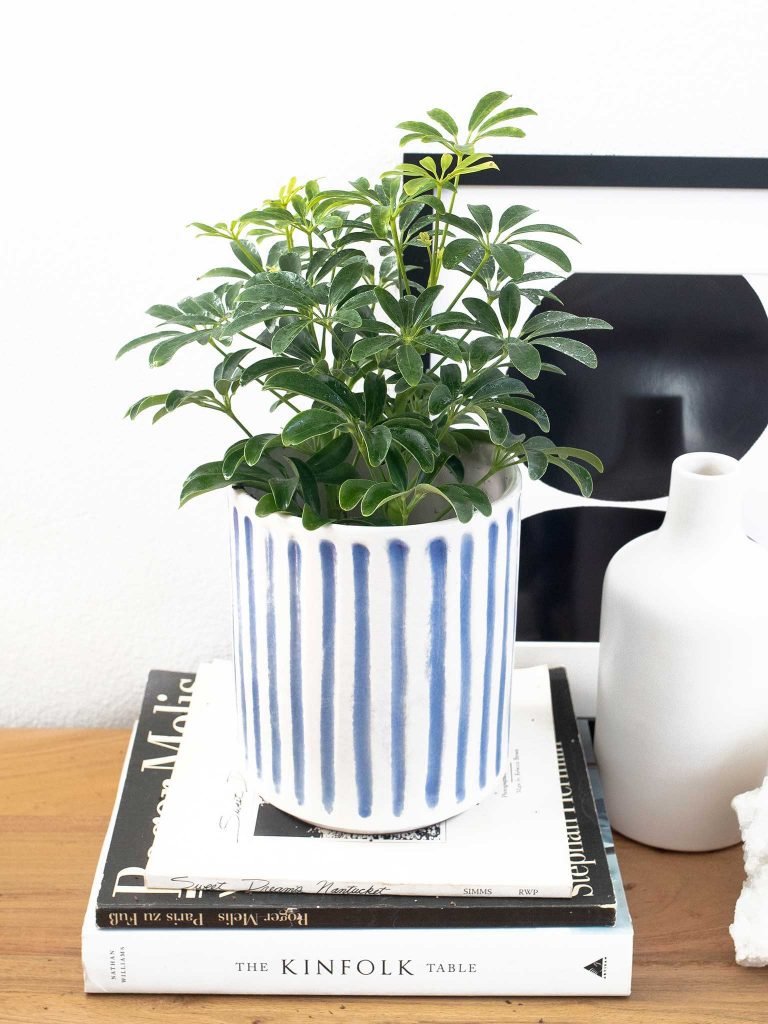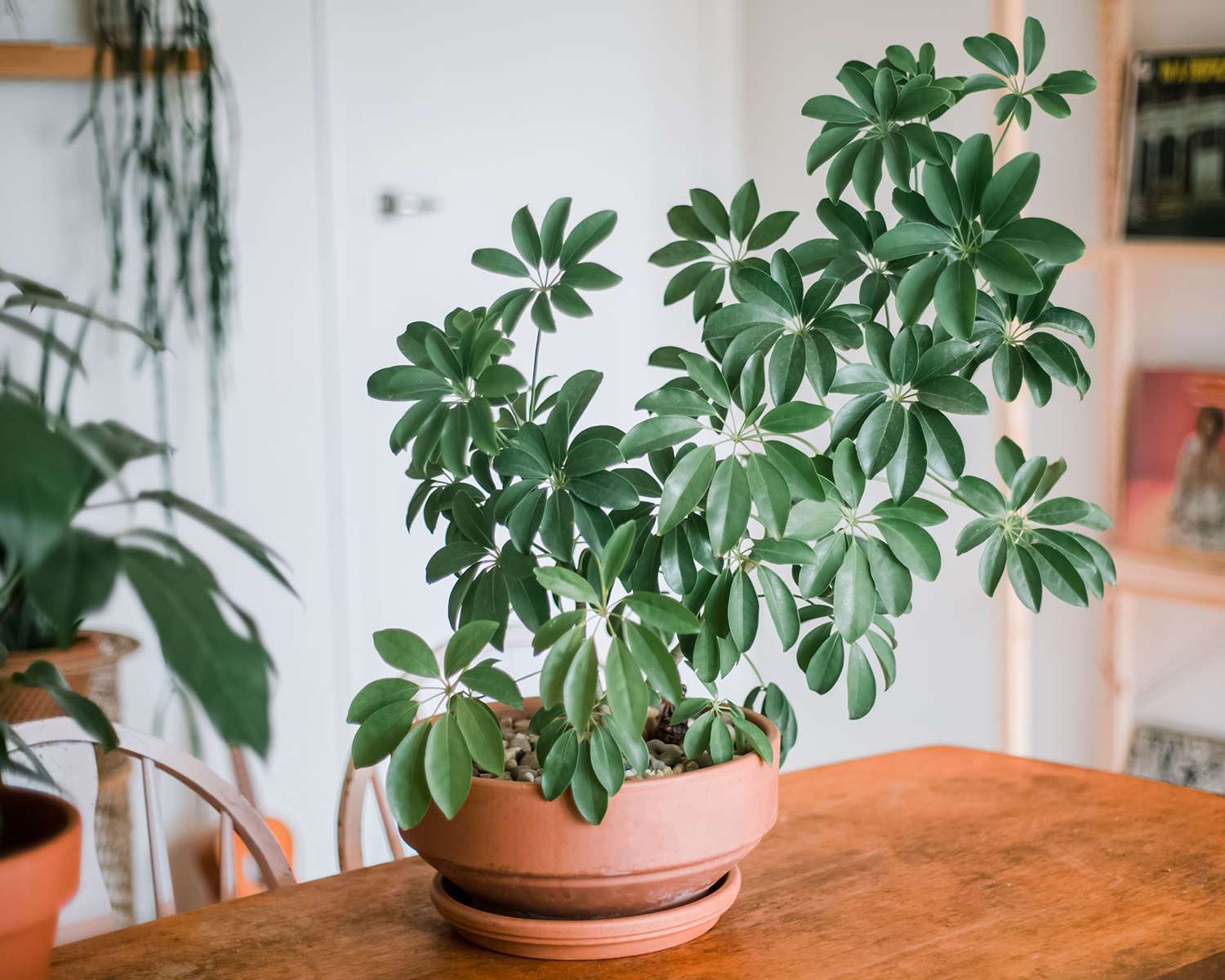Umbrella Plant (Schefflera arboricola) Overview
Today, I’m excited to share my personal experiences and knowledge in growing one of the most delightful houseplants out there – the Umbrella Plant, or as the botanists call it, Schefflera arboricola. This plant, with its beautiful, glossy leaves that spread out like the ribs of an umbrella, doesn’t just add a touch of the tropics to your living space but also plays a role in purifying the air. Whether you’re an experienced plant enthusiast or just starting your journey into the world of houseplants, my guide is here to help you navigate the dos and don’ts of Umbrella Plant care. So, let’s get started and learn together about nurturing this gorgeous green friend! 🌿☂️
Nicknames: Umbrella Plant, Dwarf Umbrella Tree, Octopus Tree, Schefflera

Umbrella Plant Care Guide
Light: Finding the Perfect Home for Your Plant 🌞
Just the Right Amount of Sun
Your Umbrella Plant likes bright places but not direct sunlight. Think of a spot near a window where the sun doesn’t hit directly, like near an east-facing window. This spot gets a gentle morning sun, which is just perfect.
What Happens If There’s Too Much or Too Little Light
If the leaves start turning yellow or brown, it might be getting too much sun. Move it away from the window a bit. If it looks like it’s reaching out for light or getting tall and thin, it needs more light. Move it closer to the window.
Using Artificial Light
If your house doesn’t get a lot of natural sunlight, don’t worry. You can use a special plant light to help your Umbrella Plant stay green and healthy.
Water: Keeping Your Plant Hydrated 💧
How Much Water Does It Need?
The trick is to water it just right – not too much and not too little. Wait until the top part of the soil feels dry, then give it a good drink. This might be about once a week, but it depends on your home.
Why Drainage is Important
Make sure your plant pot has holes at the bottom. This lets extra water run out, so the roots don’t get too wet and rot.
Change with the Seasons
Your plant might need more water in the summer or if your house is really warm. In cooler weather, it might need less. Keep an eye on it and adjust as needed.
Soil: The Best Foundation for Your Plant 🌱
The Right Type of Soil
A potting mix that drains well is best for Umbrella Plants. You can find soil like this at any garden store. It’s usually labeled for indoor plants and helps water flow through easily.
Temperature and Humidity: Making Your Plant Comfy 🌡️💦
The Best Temperature
Your Umbrella Plant likes it cozy – between 60-75°F (15-24°C). Keep it away from cold drafts, heaters, or air conditioners.
How Humid Should It Be?
These plants love a bit of moisture in the air. If your house is dry, especially in winter, try using a humidifier or putting a tray with water and pebbles under the plant pot. You can also lightly mist the leaves sometimes.
Adjusting to Your Home
Every house is different, so watch how your plant reacts and move it around if you need to, until you find the spot where it looks happiest.
Fertilizer: Giving Your Plant a Boost 🌼
Feeding Your Plant
Fertilizer helps your plant grow big and strong. Use a general houseplant fertilizer, but mix it with more water than the instructions say. This way, it’s not too strong for your plant.
When to Fertilize
Feed your plant once a month in spring and summer. Don’t worry about fertilizing in fall and winter – your plant doesn’t need it then.
Watching for Signs
If the leaves turn yellow or the plant isn’t growing much, it might need more food. If the tips of the leaves turn brown or there’s a white crust on the soil, it might be getting too much. Adjust how much fertilizer you use as needed.
That’s it! With these simple tips, your Umbrella Plant should thrive and bring a bit of nature’s beauty into your home. So, keep an eye on your green buddy and enjoy the journey of growing together! 🌿💚
Mastering the Art of Growing the Umbrella Plant
How to Propagate Your Umbrella Plant 🌱
The Magic of Propagation
Propagation is the process of creating new plants from an existing one. For Schefflera, the most common method is stem cuttings. It’s a simple and rewarding way to multiply your plant collection or share it with friends.
Step-by-Step Propagation
- Choosing the Cutting: Look for a healthy stem, about 4-6 inches long, with several leaves. Cut just below a leaf node (where leaves attach to the stem).
- Preparing the Cutting: Remove the lower leaves, leaving a few at the top. This ensures that the plant focuses its energy on root development.
- Rooting the Cutting: You can root your cutting in water or directly in soil. For water rooting, place the stem in a jar of water, making sure no leaves are submerged. Change the water every few days. For soil rooting, plant the stem in moist potting soil and cover it with a plastic bag to create a greenhouse effect.
- Patience is Key: Roots should start to form in a few weeks. Once they’re about an inch long in the water, or you notice new growth in the soil, it’s time to pot the new plant.
Potting and Repotting: Ensuring a Healthy Home for Your Schefflera 🌻
The Right Potting Mix
Scheffleras prefer a well-draining potting mix. A mixture of peat, perlite, and pine bark is ideal. This ensures proper drainage and prevents waterlogging, which is crucial to avoid root rot.
When to Repot
Scheffleras don’t mind being a bit root-bound, but they do require repotting every 2-3 years. Signs it’s time to repot include roots growing through drainage holes or a slowdown in growth.
Repotting Steps
- Choosing the Right Pot: Select a pot that’s 1-2 inches larger in diameter than the current one. Make sure it has drainage holes.
- The Repotting Process: Gently remove the plant from its current pot. Loosen the roots and remove any dead or rotted ones. Place the plant in the new pot and fill it with fresh potting mix. Water it thoroughly.
- Aftercare: Keep the newly potted plant in a shaded area for a few days to recover. Avoid fertilizing for about a month to prevent burning the fresh roots.
Pruning: Keeping Your Umbrella Plant in Shape ✂️
Why Pruning is Essential
Pruning is not just about aesthetics; it’s vital for the health of your Schefflera. It encourages new growth, helps maintain an attractive shape, and removes any dead or diseased parts.
Pruning Techniques
- Timing: The best time to prune is in the spring or early summer when the plant is actively growing.
- How to Prune: Use clean, sharp scissors or pruning shears. Cut just above a leaf node or a branching point. Don’t be afraid to cut back up to a third of the plant if needed; Scheffleras respond well to pruning.
- Shaping Your Plant: Focus on creating a balanced shape and removing overcrowded or leggy branches. This will improve light penetration and air circulation within the plant.
Navigating Through Pests and Diseases
Battling Pests: Keeping Your Schefflera Safe 🐛
Identifying Common Culprits
The most frequent pests you’ll encounter with Schefflera are spider mites, mealybugs, and aphids. These tiny invaders can be hard to spot but look for telltale signs like webbing, white cottony substances, or small bugs on the underside of leaves.
Effective Pest Control Strategies
- Regular Inspection: Make it a habit to inspect your Umbrella Plant regularly. Early detection is key to controlling infestations.
- Isolation: If you spot pests, isolate your plant to prevent them from spreading to other houseplants.
- Neem Oil: A go-to for organic pest control, neem oil is effective against a wide range of pests. Apply it according to the package instructions.
- Insecticidal Soap: Another safe option for treating pests is insecticidal soap. It’s especially effective against aphids and spider mites.
- Manual Removal: For light infestations, wiping the leaves with a cloth dipped in soapy water can be effective.
Preventing Pest Attacks
Keeping your plant healthy is the best defense against pests. Proper watering, adequate light, and regular fertilization help strengthen your plant’s resistance.
Tackling Plant Diseases: A Guide to Schefflera Health 🌱
Common Diseases in Schefflera
The most common diseases affecting the Umbrella Plant are root rot and leaf spot diseases. Root rot is often a result of overwatering, while leaf spots can be caused by fungal or bacterial infections.
Solutions for Plant Diseases
- Root Rot: If your plant suffers from root rot, act quickly. Remove it from its pot, trim away the rotted roots, and repot it in fresh, well-draining soil. Ensure your pot has adequate drainage holes.
- Leaf Spot Diseases: For leaf spot diseases, remove the affected leaves and apply a fungicide if necessary. Improving air circulation around the plant also helps.
Preventive Measures
Prevention is better than cure, especially in plant care. Avoid overwatering, ensure good drainage, and don’t let water sit on the leaves for too long.
Common Problems with Schefflera: Troubleshooting Tips 🤔
Yellowing Leaves
If your Umbrella Plant’s leaves turn yellow, it could be a sign of overwatering, poor drainage, or a nutrient deficiency. Adjust your watering schedule, check your pot for drainage, and consider a balanced fertilizer.
Dropping Leaves
Leaf drop can be alarming, but it’s often a response to stress. This can be due to a sudden change in temperature, light, or watering habits. Ensure a stable environment for your plant to recover.
Leggy Growth
Leggy or stretched-out plants usually indicate inadequate light. Move your Schefflera to a brighter spot, but avoid direct sunlight, which can scorch the leaves.
Tips for a Healthy Plant
- Consistent Care: Stick to a regular watering and fertilizing schedule.
- Adequate Light: Ensure your plant receives bright, indirect light.
- Regular Cleaning: Dust the leaves to ensure they can photosynthesize efficiently.
Pros and Cons of Owning an Umbrella Plant
As an experienced home gardener, I’ve learned that owning an Umbrella Plant brings its mix of delights and hurdles. Let me give you a quick rundown of what you can expect:
| Pros | Cons |
|---|---|
| 🌞 Adapts to Lighting: Thrives in both bright, indirect light and lower light conditions. | ☀️ Sensitive to Direct Sunlight: Can get scorched in too much direct light. |
| 💧 Moderate Watering: Likes moist soil, but doesn’t need constant watering. | 💧 Risk of Overwatering: Too much water can lead to root rot. |
| 🌱 Steady Growth: Offers a satisfying growth journey, with visible development over time. | 🌵 Requires Pruning: Needs regular pruning to maintain shape and health. |
| 🏡 Air Purifying: Known for its air-purifying qualities, enhancing your home’s environment. | 🐾 Toxic to Pets: Harmful if ingested by pets, requiring cautious placement. |
| 🪴 Easy to Repot and Propagate: Repotting and propagating are straightforward, perfect for beginners. | 🌡️ Temperature Sensitive: Prefers a consistent temperature range, might not thrive in fluctuating conditions. |
Taking care of a Schefflera arboricola is a delightful and rewarding experience. Their lush foliage and easy-going nature make them a fantastic addition to any indoor garden. Remember, patience and consistent care are the keys to a healthy, thriving plant. Enjoy the journey of nurturing your Umbrella Plant, and watch as it brings a touch of the tropics to your home! 🌴🌱✨
For more detailed information, feel free to check out the Wikipedia page on Schefflera arboricola.
Megan Stewart, a houseplant aficionado and biologist, resides in the city of Portland, Oregon, USA. Her passion for greenery is matched only by her academic prowess; Megan holds a degree in Biology from the University of Oregon. This background has provided her with a rich understanding of the biological intricacies of plant life, which she skillfully applies to her collection of indoor plants.
Megan's home is a testament to her love for all things green, filled with a diverse array of houseplants ranging from exotic orchids to robust succulents. When she's not tending to her indoor garden, she spends her time with her beloved pets, a constant source of companionship and joy. Her articles are a reflection of her life's passions, offering readers a blend of practical plant care advice, and insightful biological tidbits.
Through her writing, Megan aims to inspire others in the USA and beyond to create their urban jungles and foster a deeper connection with nature.


